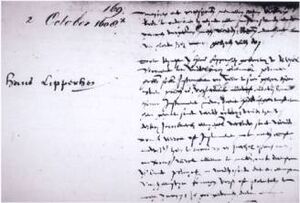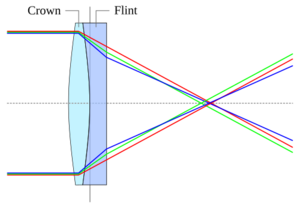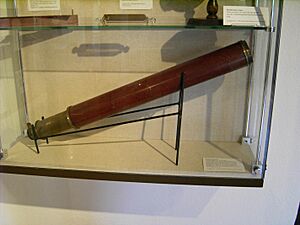History of the telescope facts for kids
The history of the telescope tells us how this amazing tool for looking at far-off things was invented and improved over time. The first known telescope appeared in 1608 in the Netherlands. An eyeglass maker named Hans Lippershey tried to get a patent for it. Even though he didn't get the patent, news of his invention quickly spread across Europe.
These early telescopes used two main parts: a convex lens at the front (called the objective) and a concave lens for the eyepiece. The next year, in 1609, Galileo made his own improved telescope and used it to study the sky. In 1611, Johannes Kepler figured out how to make an even better telescope using two convex lenses. By 1655, astronomers like Christiaan Huygens were building powerful, but very long, Keplerian telescopes.
Isaac Newton is famous for building the first reflecting telescope in 1668. His design used a small flat mirror to bounce light to an eyepiece on the side. Later, in 1672, Laurent Cassegrain described a different type of reflector. It used a small convex mirror to send light through a hole in the main mirror.
A big step forward for refracting telescopes was the achromatic lens. This special lens greatly reduced blurry colors and allowed for shorter, more useful telescopes. Chester Moore Hall made the first one in 1733, but he didn't tell many people. John Dollond later learned about it and started selling these improved telescopes in 1758.
Reflecting telescopes also got better. John Hadley made larger, more accurate mirrors in 1721. In 1857, Léon Foucault found a way to coat glass mirrors with silver, which was much better than older metal mirrors. Then, in 1932, mirrors started being coated with aluminum, which lasted even longer. The Ritchey-Chretien design, invented around 1910, became popular after 1950. Many modern telescopes, like the Hubble Space Telescope, use this design because it gives a wider view.
Between 1850 and 1900, many large "Great Refractors" were built. These were huge telescopes with lenses up to 1 meter (about 3 feet) wide. The biggest was the Yerkes Observatory refractor in 1897. However, after 1900, even larger reflecting telescopes with glass mirrors began to be built. These included the 1.5-meter (60-inch) Mount Wilson telescope and the 2.5-meter (100-inch) Hooker Telescope (1917). The 5-meter (200-inch) Hale telescope was finished in 1948. Almost all major research telescopes since 1900 have been reflectors.
New technologies in the 1970s and 1980s led to even bigger telescopes. These included computer-controlled mounts and active optics. This allowed for giant telescopes like the 10-meter (400-inch) Keck telescopes (1993/1996) and the 8-meter ESO Very Large Telescope.
The age of radio telescopes began in 1931 when Karl Guthe Jansky accidentally found radio waves coming from space. In the 20th century, many different types of telescopes were made to see different kinds of light, from radio waves to gamma-rays. After 1960, space observatories were launched. These allowed scientists to see types of light that can't pass through Earth's atmosphere, like X-rays and some infrared light.
Optical Telescopes
How Lenses Work
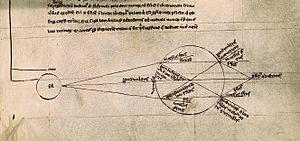
People have found objects that look like lenses from 4000 years ago. We don't know if they were used to see things better or just as decorations.
Ancient Greeks wrote about how water-filled spheres could bend light. Later, scientists like Ptolemy (in the 2nd century) and Ibn Al-Haytham (in the 11th century) studied how light reflects and bends.
Lenses were definitely used when eyeglasses became common in Italy in the late 1200s. People started using concave lenses to help with near-sightedness around 1451.
The Invention of the Telescope
The first official record of a telescope is from the Netherlands in 1608. A spectacle-maker from Middelburg, Hans Lippershey, asked for a patent for his device. He said it could "see things far away as if they were nearby." A few weeks later, another Dutch maker, Jacob Metius, also applied for a patent.
The government didn't give a patent because it seemed many people already knew about the device. However, the Dutch government did pay Lippershey to make copies of his design.
The first Dutch telescopes used a convex lens and a concave lens. This design meant the image you saw was not upside down. Lippershey's first telescope only made things look 3 times bigger. Soon after its invention, many telescopes were made in the Netherlands and quickly spread across Europe.
Who Invented It First?

There have been some arguments about who invented the telescope first. In 1655, a Dutch diplomat named William de Boreel tried to find out. He heard from a spectacle maker named Johannes Zachariassen, who said his father, Zacharias Janssen, invented the telescope and microscope as early as 1590. This claim was later supported by some historians, but others found problems with Zachariassen's story.
There were also claims that an English scientist, Leonard Digges, had a "far seeing glass" in the mid-1500s. This idea came from a book by his son, Thomas Digges, in 1571. Some believed it was a type of reflecting/refracting telescope. However, seeing tiny details from seven miles away with the technology of that time seems unlikely. It might have been a simpler magnifying glass.
In 1959, a researcher suggested that a French spectacle maker, Juan Roget, might have built an early telescope before Lippershey. Also, in 2022, a physics professor named Alessandro Bettini explored if Leonardo da Vinci could have invented a telescope, based on some of his drawings.
How the Invention Spread
Lippershey's patent application was mentioned in a report about a visit from the King of Siam to Holland in October 1608. This report was shared across Europe. Scientists like the Italian Paolo Sarpi and the English astronomer Thomas Harriot quickly started experimenting. Harriot used a telescope by the summer of 1609 to observe the Moon.
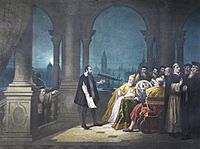
Galileo Galilei was in Venice in June 1609 when he heard about the "Dutch perspective glass." This was a military spyglass that made distant objects look closer. Galileo said he figured out how to build one the very next night after returning home. He made his first telescope using a convex lens at one end of a lead tube and a concave lens at the other. This design is now called a Galilean telescope.
A few days later, he made an even better telescope. He showed it to the public in Venice and presented it to the Doge (leader) of Venice. In return, Galileo was given a lifetime teaching job and double his salary.
Galileo worked hard to improve his telescopes. His first one magnified things 3 times, but he soon made instruments that magnified 8 times, and finally, one that magnified 23 times. With this powerful telescope, he began his famous astronomical observations in late 1609. He saw the moons of Jupiter, mountains and valleys on the Moon, the phases of Venus, and spots on the Sun.
Galileo noticed that the moons of Jupiter orbited Jupiter, Venus had phases like our Moon, and the Sun rotated. These observations supported the idea that the Sun was the center of our solar system (the Copernican system), rather than the Earth being the center (the Ptolemaic system).
Galileo's instrument was the first to be called a "telescope." This name was created by a Greek poet, Giovanni Demisiani, in 1611. It comes from the Greek words tele (far) and skopein (to look or see), meaning "far-seeing."
By 1626, knowledge of the telescope reached China. A German Jesuit and astronomer, Johann Adam Schall von Bell, published a book about it in Chinese and Latin.
Improving Telescopes
Refracting Telescopes
Johannes Kepler was the first to explain how a telescope with two convex lenses could work better. He wrote about it in 1611. The first person to actually build one of these was Christoph Scheiner.
William Gascoigne realized a key advantage of Kepler's design: a small object could be placed where the objective and eyepiece lenses met. This led him to invent the micrometer and use telescopes for precise astronomical measurements. Kepler's telescope became widely used by the mid-1600s because it had a much wider view than Galileo's design.
Christiaan Huygens built the first powerful Keplerian telescopes with the help of his brother. With one of these, which had a lens about 5.7 cm (2.24 inches) wide and was 3.6 meters (12 feet) long, he discovered Titan, one of Saturn's moons, in 1655. In 1659, he published his work explaining Saturn's ring for the first time.
Very Long Refractors
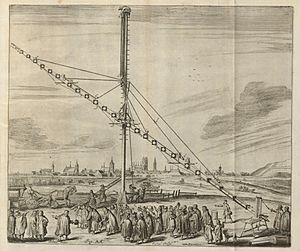
The clarity of images in Kepler's telescope was limited by chromatic aberration. This is a color blur caused by different colors of light bending unevenly through the lens. To fix this for high magnification, lenses had to be made with very long focal lengths.
Astronomers like Giovanni Domenico Cassini used telescopes 10.6 meters (35 feet) long. Johannes Hevelius built telescopes as long as 45 meters (150 feet)! These telescopes had incredibly long tubes and needed huge scaffolds or cranes to hold them up. They were very hard to use because the long tubes would bend and shake in the slightest breeze, sometimes even collapsing.
Aerial Telescopes
Some of the very long refracting telescopes built after 1675 didn't even have a tube. The main lens was mounted on a pole, tree, or tall building. It was aimed using a string or rod. The eyepiece was held by hand or on a stand at the focus. Finding the image was a challenge! These were called aerial telescopes. Christiaan Huygens and his brother made lenses up to 210 feet long. Others made them up to 600 feet long. These telescopes were extremely difficult to use and required great skill and patience.
Reflecting Telescopes
People probably knew that curved mirrors could form images since ancient times. Alhazen studied this in the 11th century. Galileo and others thought about using a mirror instead of a lens to form the main image in a telescope. In 1616, Niccolò Zucchi tried replacing a refractor's lens with a bronze concave mirror, but he didn't get a good image. This was likely due to a poor mirror or his head blocking the view.

In 1636, Marin Mersenne suggested a telescope design with two curved mirrors. One mirror would have a hole in the middle to let the light pass through. James Gregory described this in more detail in 1663. He showed that a reflecting telescope with specially shaped mirrors could fix blurry images and color problems. This design is called the "Gregorian telescope." However, Gregory couldn't find anyone skilled enough to build it.


In 1666, Isaac Newton realized that the problems with refracting telescopes were due to lenses bending different colors of light unevenly. He thought that no lens could fix this color blur. Newton's experiments with mirrors showed they didn't have this problem. So, he decided to build a reflecting telescope.
Newton finished his first telescope in 1668. It was the first working reflecting telescope. He used a special metal alloy (tin and copper) for his main mirror. He also figured out how to grind and polish mirrors. To make it simpler, he made his mirror spherical instead of parabolic.
Newton added a small "diagonal" mirror near the main mirror's focus. This mirror bounced the image at a 90-degree angle to an eyepiece on the side of the telescope. This clever idea allowed the image to be seen without blocking the main mirror. Newton's first compact reflector had a 3.3 cm (1.3 inch) mirror. With it, he could see Jupiter's four largest moons and the crescent shape of Venus.
Encouraged, he made a second telescope that magnified 38 times. He showed it to the Royal Society of London in 1671. This type of telescope is still called a Newtonian telescope.

In 1672, Laurent Cassegrain designed a third type of reflecting telescope, the "Cassegrain reflector." It used a small convex mirror to reflect light through a central hole in the main mirror.
For about 50 years, not much changed in reflecting telescopes. Then, John Hadley (who invented the octant) found ways to make very precise parabolic mirrors from speculum metal. In 1721, he showed the first parabolic Newtonian reflector to the Royal Society. It had a 15 cm (6 inch) mirror. Scientists compared it to a large refracting telescope and found Hadley's reflector worked just as well, though the image wasn't quite as bright.
Hadley's methods for polishing mirrors were passed on, and soon, opticians in London started making these telescopes. James Short began making Gregorian telescopes in the 1730s. He became a professional telescope maker and made a lot of money selling them.
Old speculum metal mirrors didn't reflect light very well and tarnished quickly. This meant they had to be removed and re-polished often, which was a lot of work. To avoid using a secondary mirror, Mikhail Lomonosov in 1762 designed a telescope where the main mirror was tilted slightly. This allowed the observer to look directly at the image without blocking the light. This design was later called the Herschelian telescope.

Around 1774, William Herschel, a music teacher in England, started building reflector telescopes. He eventually dedicated his life to astronomy. In 1778, he built a 20 cm (6.25 inch) reflector that was 2.1 meters (7 feet) long. With this telescope, he made many important discoveries. In 1783, he finished an 45 cm (18 inch) reflector.
In 1789, Herschel completed his largest reflecting telescope. It had a 124 cm (49 inch) mirror and was 12 meters (40 feet) long. This was known as his 40-foot telescope. To reduce light loss from the poor mirrors of the time, Herschel tilted his main mirror and looked directly at the image. This is the Herschelian telescope design. The first night he used it, he discovered Enceladus, one of Saturn's moons. This telescope was the largest in the world for over 50 years, but it was hard to use.
In 1845, William Parsons, 3rd Earl of Rosse built his 183 cm (72 inch) Newtonian reflector called the "Leviathan of Parsonstown." With it, he discovered the spiral shapes of galaxies.
All these large reflectors had problems with their speculum metal mirrors. They didn't reflect light well and tarnished quickly. This meant mirrors had to be frequently removed and re-polished. This was a long process because polishing could change the mirror's shape, so it often had to be "re-figured" to be correct.
Achromatic Refracting Telescopes
When the first refracting telescopes were invented, people thought the color problems were just from imperfect lens shapes. Opticians tried to make lenses with different curves to fix this. But Isaac Newton discovered in 1666 that the colors came from light bending unevenly as it passed through the glass. He incorrectly thought that no lens could fix this.
This led opticians to try making lenses from more than one type of glass. The goal was to create an "achromatic lens" that would focus all colors to a single point, allowing for shorter, better telescopes.
The first person to make a working achromatic refracting telescope was Chester Moore Hall in England. He realized that since the human eye can see without color blur, it should be possible to make a lens that does the same. In 1733, he made telescope lenses with much less color blur. One of his telescopes had a 6.3 cm (2.5 inch) lens with a short focal length of 50 cm (20 inches).
Hall didn't care much for fame and didn't tell the world about his invention. Later, when John Dollond got a patent for the achromatic telescope, it was ruled that Hall was the first inventor. However, the judge said that the person who shares their invention for the benefit of everyone should profit, not the one who keeps it secret.
In 1747, Leonhard Euler tried to prove that both color and shape problems in lenses could be fixed. He argued that since the human eye's parts work together to create a perfect image, lenses made of different materials could do the same.
Euler's attempts to build such a lens failed, which he blamed on the difficulty of making lenses with the exact curves needed. John Dollond agreed with Euler's math but disagreed with his ideas, saying they went against Newton's experiments.
However, Dollond later received a paper from a Swedish mathematician, Samuel Klingenstierna. This paper made Dollond doubt Newton's findings on how light spreads. Dollond then experimented himself and found that different types of glass bent colors differently. This quickly led him to build lenses that corrected both color and shape problems.
Dollond's writings show that he was close to this discovery even before Klingenstierna's paper. In 1765, Peter Dollond (John's son) introduced the triple objective lens, which used three lenses together.
It was hard to get large, pure pieces of glass, especially flint glass, for these achromatic telescopes. This limited how big the lenses could be. The problems with metal mirrors in reflecting telescopes led to the building of large refracting telescopes. By 1866, refractors were 45 cm (18 inches) wide. Many larger "Great refractors" were built in the late 1800s.
In 1897, the refractor reached its practical limit with the 100 cm (40 inch) refractor at Yerkes Observatory. A larger one was temporarily shown at the Paris 1900 Exposition, but no larger refractors could be built for research. This is because a large lens can only be held by its edges. The center of a very large lens would sag due to gravity, blurring the image.
Large Reflecting Telescopes
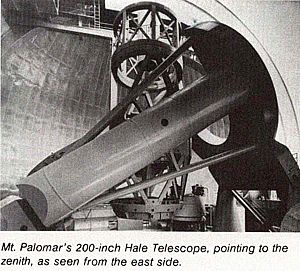
In 1856–57, Karl August von Steinheil and Léon Foucault found a way to put a layer of silver on glass telescope mirrors. Silver was much more reflective and lasted longer than older metal mirrors. Plus, the silver could be removed and re-applied without changing the glass mirror's shape. By the late 1800s, very large silver-on-glass reflecting telescopes were being built.
The early 1900s saw the first "modern" large research reflectors. These were designed for precise photography and placed in clear, high-altitude locations. Examples include the 1.5-meter (60-inch) Hale telescope (1908) and the 2.5-meter (100-inch) Hooker telescope (1917), both at Mount Wilson Observatory. These telescopes needed their mirrors re-silvered every few months.
In 1932, John Donavan Strong developed a way to coat mirrors with a much longer-lasting aluminum coating using a special vacuum process. Three years later, the 1.5-meter and 2.5-meter telescopes became the first large ones to have their mirrors aluminized.
In 1948, the 5-meter (200-inch) Hale reflector was finished at Mount Palomar. It was the world's largest telescope for 27 years. The Hale reflector introduced new ideas like special bearings for very low friction and a strong frame that kept the mirrors in shape. It also used Pyrex glass, which doesn't expand much with temperature changes. Even larger telescopes needed new ways to keep the mirror's shape perfect.
Active and Adaptive Optics
The 1980s brought two new technologies for building bigger telescopes and getting clearer images: active optics and adaptive optics.
With active optics, a computer checks the image of a star several times a minute. It then adjusts many supports under the main mirror and moves the secondary mirror. This keeps the telescope's optics in the best possible shape. This method is too slow to fix atmospheric blurring, but it allows for very thin mirrors up to 8 meters (26 feet) wide, or even larger mirrors made of segments. The ESO New Technology Telescope first used this in the late 1980s.
The 1990s saw a new generation of giant telescopes using active optics. This started with the first of the two 10-meter (33-foot) Keck telescopes in 1993. Other giant telescopes built since then include the two Gemini telescopes, the four separate telescopes of the Very Large Telescope, and the Large Binocular Telescope.

Adaptive optics works similarly but makes corrections hundreds of times per second. This helps to fix the rapid blurring caused by air movement in Earth's atmosphere. Adaptive optics measures how light waves are distorted and then uses tiny, fast-moving parts on a small mirror to correct them. This idea was first thought of in 1953, but it only became practical in the 1990s when computers and detectors became fast enough.
For adaptive optics to work well, a bright star is needed very close to the object you want to observe. Sometimes, scientists create an artificial star using a laser. These systems work best in infrared light and for looking at single objects. Newer adaptive optics systems are being developed to use multiple lasers and work at faster speeds to correct visible light.
Other Wavelengths
The 20th century saw telescopes that could create images using light other than visible light. This began in 1931 when Karl Jansky found that objects in space gave off radio waves. After World War II, a new age of astronomy began, with telescopes being made for all parts of the electromagnetic spectrum, from radio waves to gamma-rays.
Radio Telescopes
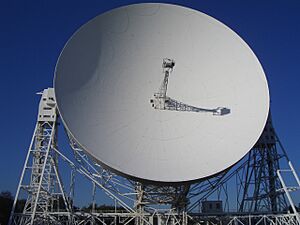
Radio astronomy started in 1931 when Karl Jansky discovered radio waves coming from the Milky Way. Building on his work, Grote Reber built a special radio telescope in 1937 with a 9.5-meter (31.4-foot) dish. He found many unexplained radio sources in the sky.
After World War II, interest in radio astronomy grew, and much larger dishes were built. These included the 76-meter (250-foot) Jodrell bank telescope (1957) and the 91-meter (300-foot) Green Bank Telescope (1962). The huge 305-meter (1000-foot) Arecibo telescope (1963) was so big it was built into a natural dip in the ground. Its central antenna could be moved to study objects. Not all radio telescopes are dishes; some use lines of antennas.
High-energy radio waves are called microwaves. This has been important since the discovery of the cosmic microwave background radiation in 1964. Many ground-based radio telescopes can study microwaves. Short microwaves are best studied from space because water vapor in Earth's atmosphere blocks them. The Cosmic Background Explorer (1989) greatly improved the study of microwave background radiation.
Because radio telescopes have low resolution, they were the first to use interferometry. This technique allows two or more telescopes far apart to observe the same source at the same time. Very long baseline interferometry extended this over thousands of kilometers, allowing for incredibly detailed images.
Telescopes like the Large Millimeter Telescope (since 2006) observe between far-infrared and longer radio wavelengths.
Infrared Telescopes
Most infrared light is absorbed by Earth's atmosphere. However, infrared astronomy can be done on high mountains where there is less water vapor. Many optical telescopes at high altitudes can also see in infrared. Some telescopes, like the 3.8-meter (150-inch) UKIRT and the 3-meter (120-inch) IRTF (both on Mauna Kea), are specifically for infrared.
The launch of the IRAS satellite in 1983 changed infrared astronomy from space. This reflecting telescope had a 60 cm (24 inch) mirror. It worked for nine months until its coolant ran out. It surveyed the entire sky and found 245,000 infrared sources, which was more than 100 times what was known before.
Ultraviolet Telescopes
Optical telescopes can see near-ultraviolet light. But the ozone layer in the atmosphere blocks ultraviolet light shorter than 300 nanometers. So, most ultraviolet astronomy is done with satellites. Ultraviolet telescopes look like optical telescopes, but they use special mirror coatings like magnesium fluoride instead of regular aluminum.
The Orbiting Solar Observatory satellite observed in ultraviolet as early as 1962. The International Ultraviolet Explorer (1978) systematically surveyed the sky for 18 years. Extreme-ultraviolet astronomy (10–100 nm) is a separate field. The Extreme Ultraviolet Explorer (1992) was a satellite that worked at these wavelengths.
X-ray Telescopes
X-rays from space don't reach Earth's surface, so X-ray astronomy must be done above the atmosphere. The first X-ray experiments were on rockets, which found X-rays from the Sun (1948) and other sources like Scorpius X-1 (1962).
Since then, X-ray telescopes (Wolter telescopes) have been built. These use special nested mirrors that gently deflect X-rays to a detector. Some early satellites did X-ray astronomy in the late 1960s. The first dedicated X-ray satellite was the Uhuru (1970), which found 300 sources. More recent X-ray satellites include Chandra (1999) and Newton (1999).
Gamma-ray Telescopes
Gamma rays are absorbed high in Earth's atmosphere, so most gamma-ray astronomy is done with satellites. Gamma-ray telescopes use special detectors like scintillation counters. These devices usually have very poor angular resolution.
Early experiments were done with balloons in the 1960s. Gamma-ray astronomy really began with the launch of the OSO 3 satellite in 1967. The first dedicated gamma-ray satellites were SAS B (1972) and Cos B (1975). The Compton Gamma Ray Observatory (1991) greatly improved gamma-ray surveys.
Very high-energy gamma-rays (above 200 GeV) can be detected from the ground. They create a special light called Cerenkov radiation when they hit the atmosphere. Several Cerenkov imaging telescopes have been built around the world, like HESS (2003) and MAGIC (2004).
Interferometric Telescopes
In 1868, Fizeau noted that a regular telescope basically changes light waves into an image. He realized that by using many small instruments, it might be possible to measure a star's size as precisely as a single telescope as large as the whole group. This technique is called astronomical interferometry.
It wasn't until 1891 that Albert A. Michelson successfully used this to measure the sizes of Jupiter's moons. Thirty years later, Michelson and Francis G. Pease (1921) directly measured a star's diameter using a 6.1-meter (20-foot) interferometer on the 100-inch Hooker Telescope.
A big step forward came in 1946 when Ryle and Vonberg used a radio version of the Michelson interferometer. They added signals from two radio antennas to create interference. This allowed them to find new cosmic radio sources. As computers got faster, they developed "aperture synthesis" imaging. This technique could get high-resolution images without needing a giant dish. It is now used in most radio astronomy.
Radio astronomers also developed ways to do aperture synthesis using much larger groups of telescopes, sometimes spread across different continents. In the 1980s, this technique was used for visible light and infrared astronomy. This gave the first very high-resolution images of nearby stars.
In 1995, this imaging technique was shown on a group of separate optical telescopes for the first time. This allowed for even better resolution and clearer images of star surfaces. The same techniques are now used at other telescope groups like the Navy Prototype Optical Interferometer and the CHARA array.
In 2008, Max Tegmark and Matias Zaldarriaga suggested a "Fast Fourier Transform Telescope" design. In this idea, lenses and mirrors wouldn't be needed at all when computers become fast enough to do all the necessary calculations.
Images for kids
See also
 In Spanish: Historia del telescopio para niños
In Spanish: Historia del telescopio para niños
- 400 Years of the Telescope documentary
- History of astronomy
- Astronomical interferometer
- Timeline of telescope technology
- Timeline of telescopes, observatories, and observing technology
- International Year of Astronomy, 2009 marking the 400th anniversary of Galileo's first astronomical observations using his telescope
- List of optical telescopes
- List of largest optical refracting telescopes
- List of space telescopes
- List of telescope types
- Visible-light astronomy


